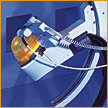| |
Description |
Advantages |
Disadvantages |
| Watchful
Waiting |
- Drinking
plenty of fluids in the hope of washing stones out of the
system.
|
- Studies
suggest that up to 95% of stones are capable of spontaneous
passage within six weeks.
|
- Occasionally,
stones do not produce any symptoms. But while they may be
"silent," they can be growing, even threatening
irreversible damage to kidney function.
|
|
Lithotripsy

|
- Uses
highly focused impulses projected from outside the body
to pulverize kidney stones anywhere in the urinary system.
- The
stone usually is reduced to sand-like granules that can
be passed in the patient's urine.
|
- A very
safe treatment.
- Does
not damage surrounding body tissue - only breaks up the
stone.
- Recovery
time is short - most people can resume normal activities
in a few days.
|
- Large
stones may require several treatments.
- Kidney
must be functioning well with no blockage to the passage
of stone fragments.
|
| Holmium Laser |
- A small
laser fiber is passed through a fiberoptic Instrument (ureteroscope)
and brought into direct contact with the stone. Laser energy
produces a shockwave effect which shatters the stone, allowing
spontaneous passage or removal.
|
- Removes
stone almost 100% of the time.
- Non-invasive
in that there is no incision.
- Outpatient
procedure with rapid return to normal activity.
- Safe
with few complications.
- Best
used for stones in the mid and lower ureter where lithotripsy
is only 80% successful in removing stones.
|
- Usually
requires placement of a stent for a short time post-op.
- Requires
general anesthesia.
|
| Drug
Therapy |
- Taking
medications to counteract the condition causing the stone
to form.
|
- Treats
the cause of the stone, not just the symptom.
- Non-invasive.
|
- Slow acting.
- Side effects of pain medication include:
- Constipation
- Drowsiness
- Nausea
- Slowed breathing (respiration)
- Vomiting
|
| Surgery |
- An
incision or incisions are made and the stone is removed
or shattered. If the latter, the pieces of the shattered
stone are passed by the patient.
- Once
the stone is located, a small, basket-like device can be
used to grasp smaller stones and remove them. Shattered
stone are passed by the patient.
|
- Reserved
for cases where other approaches have failed.
|
- Invasive
and painful.
- Possibility
that the ureteral wall could be damaged or torn.
- Chance
of air or fluids forming around the lung if the access channel
is made toward the upper portion of the kidney.
- Possible
injury to the bowel or the blood vessels within the kidney.
- Requires
hospitalization.
|


